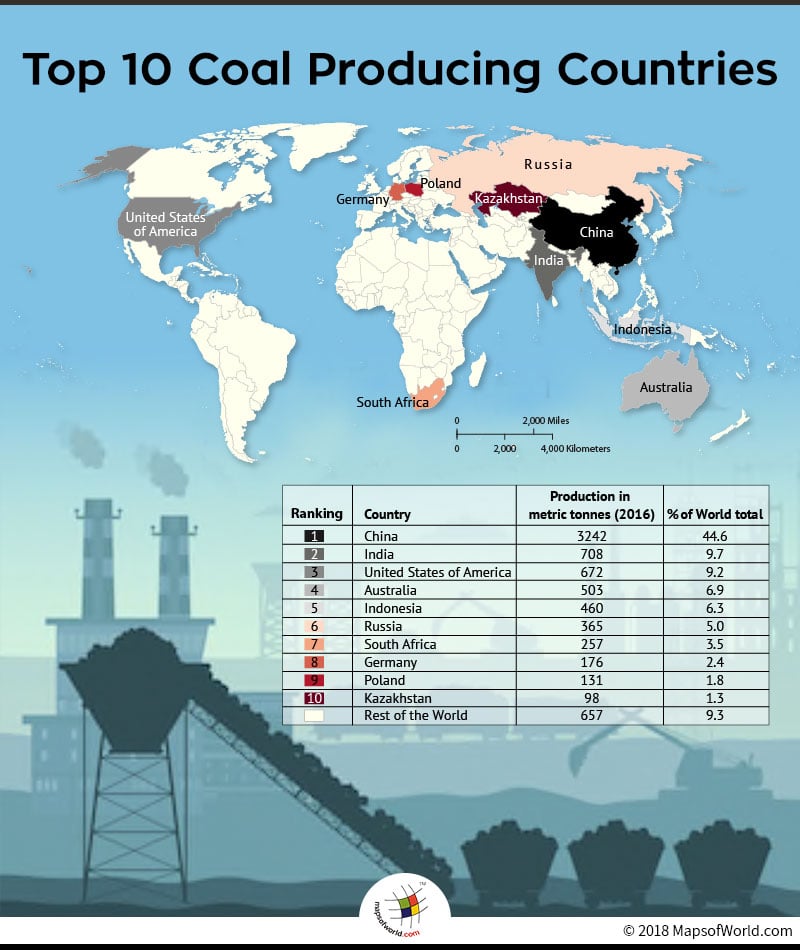What are the top 10 coal producing nations?
In face of the rising carbon footprints and increasing vigilance amongst nations, and the collective efforts towards achieving sustainable development, places energy at the heart of the agenda. This includes; accessibility to electricity, improving cooking fuels, decreasing wasteful energy subsidies and curbing air pollution. The SDG -7, aims at ensuring affordable- sustainable energy for all and shifting the reliance from the non-renewable resources like COAL.
The extraction of coal is largely done to meet the energy requirements around the world. It is also used as a fuel for the extraction of iron from its ore and in the cement industries. With the growing population there is an ever-increasing pressure on coal reserves, and the need to switch to other energy sources is apparent.
In order to address the concern of sustainable life on the planet, the World Coal Association, is involved in international climate talks and held the 23rd Conference of the Parties (UNFCCC, COP 23), to further the steps taken in the direction of sustainable development.
Additionally, as part of the Nationally Determined Contributions, drafted in the Paris Agreement, different countries have adopted ‘High Efficiency Low Emissions Technology.’ The global share of the coal giant China, has also led to a surge in the global coal production levels. Some 40% of the electricity generated comes from coal and over 7,200 million metric tons is produced globally. These are inclusive of all the varieties like steam coal, coking coal, lignite and recovered coal.
The International Energy Agency places China on the first rank for coal production. The country’s thirst for coal is reflected by the level of production, as 44.6% of the global production share. This is also exhibited by the greenhouse emissions of China. In an effort to contain the climatic changes, the country has proposed to deliver the world’s largest Carbon Market on the lines of the Paris Agreement. The cleaner credentials of the country are supported by a $360 billion-dollar investment in renewable energy and withdrawal of building 85 coal-fired plants.
The developing country of India is placed second on its coal consumptions. The country moves towards an expanding economy, largely driven by energy. To fuel the highly ambitious goal of the nation, of achieving a coal production level of 1,500,000 tons by 2020, a hike in the domestic coal production is necessitated. To counter balance this huge coal hunger, India is attempting to work towards a low carbon emissions pathway, while endeavoring the developmental challenges the country faces. These are reflecting in the INDC, which offers the reduction in the emissions intensity of its GDP by 33% to 35%, addition of a carbon sink of 2,500,000 to 3,000,000 tons and anchoring a Global Solar Alliance.
The United States, which produces 672 metric tons of coal, is ranked third amongst the top coal producing nations. The goal of the nation remains clear, which is to help the nation and the world use coal as clean as possible. The country propounded the emerging technology of ‘Carbon Capture and Sequestration’ (CCS): It is to capture carbon dioxide before it is released into the atmosphere.
The world’s appetite for coal is ascending. Hence, its brings upon the global coal giants to take responsibility for the sustainable use of this resource. The nations have collectively agreed to phase out the existing traditional coal power stations, through climate financing and adopting practical methods in the transition towards the use of clean energy.
Below lying table depicts the top 10 coal producing nations:
|
Ranking |
Country |
Production in Million tonnes (2015) |
% of world total |
|
1 |
China |
3242 |
44.6 |
|
2 |
India |
708 |
9.7 |
|
3 |
United States of America |
672 |
9.2 |
|
4 |
Australia |
503 |
6.9 |
|
5 |
Indonesia |
460 |
6.3 |
|
6 |
Russia |
365 |
5.0 |
|
7 |
South Africa |
257 |
3.5 |
|
8 |
Germany |
176 |
2.4 |
|
9 |
Poland |
131 |
1.8 |
|
10 |
Kazakhstan |
98 |
1.3 |
Know more:
Related maps:


